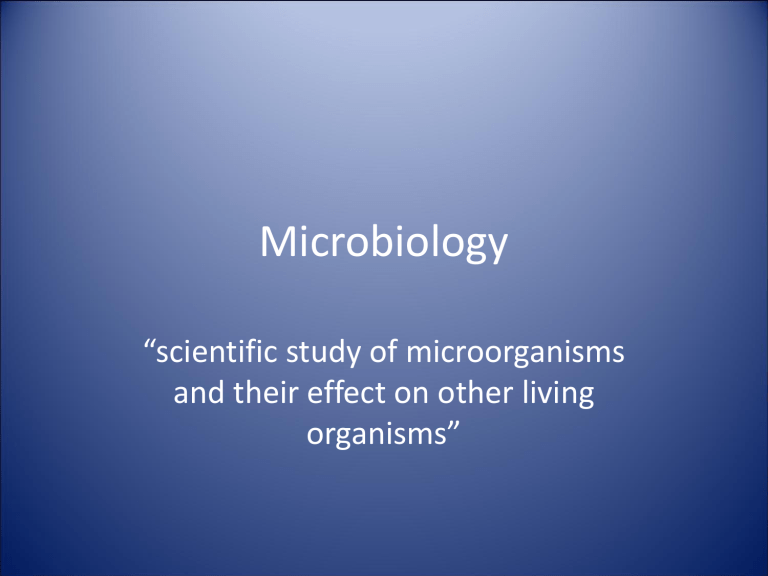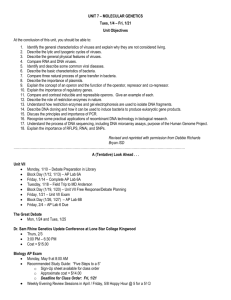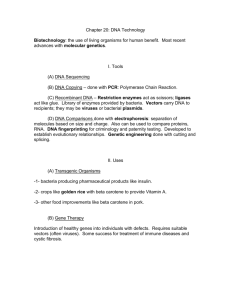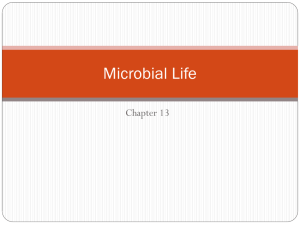Microbiology

Microbiology
“scientific study of microorganisms and their effect on other living organisms”
Naming Microorganisms
• Page 266
• staphyl = “clustered together”
• coccus = “shaped like a sphere or ball”
• aureus = “a golden-yellow color”
• Staphylococcus aureus
Classification
(Page 268)
• Kingdom
• Division or Phylum
• Class
• Order
• Family
• *Genus
• *Species
• “King Phillip Came Over From Great Spain”
Staphylococcus aureus
• genus = Staphylococcus
• species = aureus
• italics : not English
• genus: abbreviated e.g. S. aureus
Categories of Cells
• Page 267
• Eukaryotic (“True Nucleus”)
– nuclei and cytoskeleton
– DNA within the nucleus
• Prokaryotic (“Before Nucleus”)
– no nuclei and no cytoskeleton
– DNA float “freely”
– Bacteria and cyanobacteria
• Page 269
• Bacteriology
• Rickettsiology
• Virology
• Protozoology
• Mycology
Divisions
Bacteriology
• “science that studies bacteria”
Bacteria
• Page 269
• “a prokaryotic one-celled microorganism of the Kingdom Monera, existing as free living organisms or as parasites, multiplying by binary fission and having a large range of biochemical properties”
• pathogenic
Mycoplasmas
• Page 270
• “bacteria of the Mycoplasma genus that are found in humans and have no cell wall; the smallest free-living organisms presently known being intermediate in size between viruses and bacteria”
• double-stranded DNA
Chlamydia
• “a large group of nonmotile, gram negative intracellular parasites”
• replicate in cytoplasm of host cells
• use host’s ATP (Adenosine triphosphate) for energy
Rickettsiology
• “area of science that studies Rickettsia”
Rickettsia
• Page 270
• “a genus of gram-negative, pathogenic, intracellular parasitic bacteria”
• rod-shaped, sphere-shaped, change shape
• reproduce within host cell
• “arthropod vectors”
• tetracycline
• sulfonamides encourage growth
Virology
• Page 272
• “the study of viruses and viral diseases”
• Virus: “one of a group of minute infectious agents, with certain exceptions (e.g. pox viruses) not resolved in the light microscope, and characterized by a lack of independent metabolism and by the ability to replicate only within living host cells”
• rod-shaped, spherical, polyhedral, tad-pole
Virion
• individual particle that consists of nucleic acid
(the nucleoid), DNA or RNA (not both), and a protein shell (capsid)
• viruses do not have ATP
Groups of Viruses
• bacterial, animal, and plant
• classified according to:
– origin: reoviruses (respiratory and enteric)
– mode of transmission: arboviruses (mosquitoes)
– manifestations: (symptoms)polioviruses, poxviruses
– geographic location: coxsackievirus (names after
Coxsacki, New York)
Prion
• “small proteinaceous infectious agents
(particles) which almost certainly do not have a nucleic acid genome and thereby resist inactivation by procedures that modify nucleic acids”
• do not contain DNA or RNA
• spongiform encephalopathies
• eg: scrapie, mad cow, Creutzfeldt-Jakob
Protozoology
• Page 271
• “science that deals with the study of protozoa”
Protozoa
• “one celled organisms of the Kingdom
Protista- most are unicellular although some are colonists”
• “first animals”
• most abundant
• “normal flora”
• classified: according to shape and method of motility
Flagellates
• smallest
• whip-like projections (move like a fishtail)
Amoebae
• “ooze about” by extending parts of their cells as “pseudopods” or “false feet”
Sporozoans
• no locomotory extensions (flagella etc.)
• move by bending, creeping, and gliding
• Parasitic (part of their life-cycle is in host cell)
• “apical complex”: anterior end which helps to penetrate the host cell
Ciliates
• largest protozoa
• “hair-like” projections (cilia): “tiny oars”
• eat other protozoa and bacteria
Mycology
• Page 271
• “the branch of science concerned with the study of fungi”
Fungus (Fungi = plural)
• “a group of diverse and widespread unicellular and multicellular organisms, lacking chlorophyll, usually bearing spores and often filamentous”
• 3 fundamental categories: yeasts, molds, dimorphic (to be studied in depth later)
• Saprophytes: fungi that grow on decomposing matter
Human Fungal Diseases
• categorized by the level of tissue penetration
• 1) superficial mycoses: outermost layers of skin and hair
• 2) cutaneous mycoses: skin, hair and fingernails and are deeper
• 3) subcutaneous mycoses: usually result of trauma; deep in the integument and underlying structures (muscle, bone)
• 4) systemic mycoses: usually originate in the lungs (histoplasmosis, blastoplasmosis)
Opportunistic Fungal Diseases
• due to suppressed immune systems
• secondary infection due to treatment for original disorder
• can be fatal and difficult to manage









